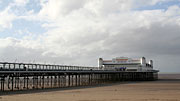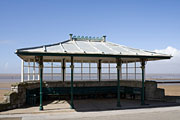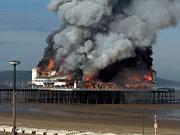The name Weston-super-Mare is made up of Saxon words meaning the west tun or settlement, and the Latin words super, meaning above, and mare, meaning sea: in other words, the village by the sea. The hillsides above the town have revealed the remains of animals such as giant deer, woolly mammoth and rhinoceros but the first evidence of people dates back to the Neolithic period. Arrowheads, flints and other tools have been found and there is evidence of Bronze Age burials in the Ashcombe area.
The remains of Iron Age Worlebury hill fort overlook the town. This stronghold was built on the site of earlier Bronze Age remains. Excavations in the 1850s produced human remains, some of which show evidence of a violent death. The skulls may be seen in the Weston-super-Mare museum.
A Roman building once stood on the site of what is now Weston College, and Romano-British pottery has been found in and around the town. After the Romans left at the beginning of the 5th century, Weston continued as a small farming and fishing village. In 1568, the mineral calamine was found on Worle Hill for the first time in Britain. This type of zinc ore was important in the production of brass. Both calamine and galena, a lead ore, continued to be mined locally well into the 19th century.
 By the middle of the 18th century, doctors advocating the drinking of and bathing in sea water. In 1789, King George III set the fashion when he tried it at Weymouth. Weston was the nearest coastal village within easy access from Bristol and Bath, so soon became popular. As most people bathed naked during the 18th century, the secluded cove at Anchor Head was chosen as Weston’s first bathing place for ladies. Gentlemen stripped off on the sands elsewhere before bathing in the water. Before long, the bathing machine was invented, giving a little more privacy. The first hotel, part of what is now the Royal Hotel,opened in 1810. Howe’s baths opened on the island of Knightstone in 1820 and bathers were ferried over until a low causeway was built to the island.
By the middle of the 18th century, doctors advocating the drinking of and bathing in sea water. In 1789, King George III set the fashion when he tried it at Weymouth. Weston was the nearest coastal village within easy access from Bristol and Bath, so soon became popular. As most people bathed naked during the 18th century, the secluded cove at Anchor Head was chosen as Weston’s first bathing place for ladies. Gentlemen stripped off on the sands elsewhere before bathing in the water. Before long, the bathing machine was invented, giving a little more privacy. The first hotel, part of what is now the Royal Hotel,opened in 1810. Howe’s baths opened on the island of Knightstone in 1820 and bathers were ferried over until a low causeway was built to the island.
The Bristol & Exeter Railway came to Weston in 1841, bringing even more holiday makers. Birnbeck Pier was built in the second part of the 19th century and the town continued to grow. There were drives and walks through Weston Woods, formerly a private game reserve, in addition to many other walks, some of which afforded lovely views as far as Exmoor and Wales. By 1890 the pier offered a multitude of entertainments. There was a theatre of wonders, an alpine railway, a shooting gallery, swings, a roundabout, cafés, a bar and numerous other attractions. On August Bank Holiday around 15,000 day trippers would visit the resort.
 The Seafront Improvement Scheme of the 1880s provided the sea walls and a promenade stretching for two miles. During the late 19th and early 20th centuries, it became fashionable for the wealthy to send their children to boarding schools at the seaside, because of the benefits to health. In 1904 the Grand Pier opened. Instead of the amusements of the earlier pier, this one had a large theatre offering all the top music hall acts. Ironically, today the pier is popular because of its modern fairground attractions.
The Seafront Improvement Scheme of the 1880s provided the sea walls and a promenade stretching for two miles. During the late 19th and early 20th centuries, it became fashionable for the wealthy to send their children to boarding schools at the seaside, because of the benefits to health. In 1904 the Grand Pier opened. Instead of the amusements of the earlier pier, this one had a large theatre offering all the top music hall acts. Ironically, today the pier is popular because of its modern fairground attractions.
 Weston-super-Mare is still a charming resort with its lines
of limestone houses, beautiful parks, the piers and sands. It is the largest seaside resort in Somerset and has all the traditional attractions of sandy beaches, donkey rides, deck chairs and the piers. There is a helicopter museum with more than 50 aircraft from around the world. This is an ideal resort for the family and there are lots of shops too. Naturally, there are lots of hotels and other accommodation, cafés, restaurants, bars and everything the tourist might need.
Weston-super-Mare is still a charming resort with its lines
of limestone houses, beautiful parks, the piers and sands. It is the largest seaside resort in Somerset and has all the traditional attractions of sandy beaches, donkey rides, deck chairs and the piers. There is a helicopter museum with more than 50 aircraft from around the world. This is an ideal resort for the family and there are lots of shops too. Naturally, there are lots of hotels and other accommodation, cafés, restaurants, bars and everything the tourist might need.
The town has its celebrities too. Author Jeffrey Archer grew up here and took the title of Lord Archer of Weston-super-Mare. He returned to Weston after his spell in prison. Jill Dando used to live here and there is a garden in memory of her. John Cleese was born in Ellesmere Road, Uphill and was a teacher in Weston before he became an actor. Even Bob Hope lived here for a while…
Addendum: Pier Fire - 28th July 2008
 On 28 July 2008 a huge fire ripped through the pavillion at the end of the the Grand Pier, totally destroying it. 11 fire engines and 80 fire-fighters were unable to contain the blaze which is believed to have been started by a deep fat fryer in the north-east tower of the Pavilion.
On 28 July 2008 a huge fire ripped through the pavillion at the end of the the Grand Pier, totally destroying it. 11 fire engines and 80 fire-fighters were unable to contain the blaze which is believed to have been started by a deep fat fryer in the north-east tower of the Pavilion.
The iron structure of the pier itself is relatively unscathed and since the fire plans have been drawn up for a new pavillion. Bristol-based architects Angus Meek won the contract and it is hoped the new structure will be open for business in the summer of 2010



